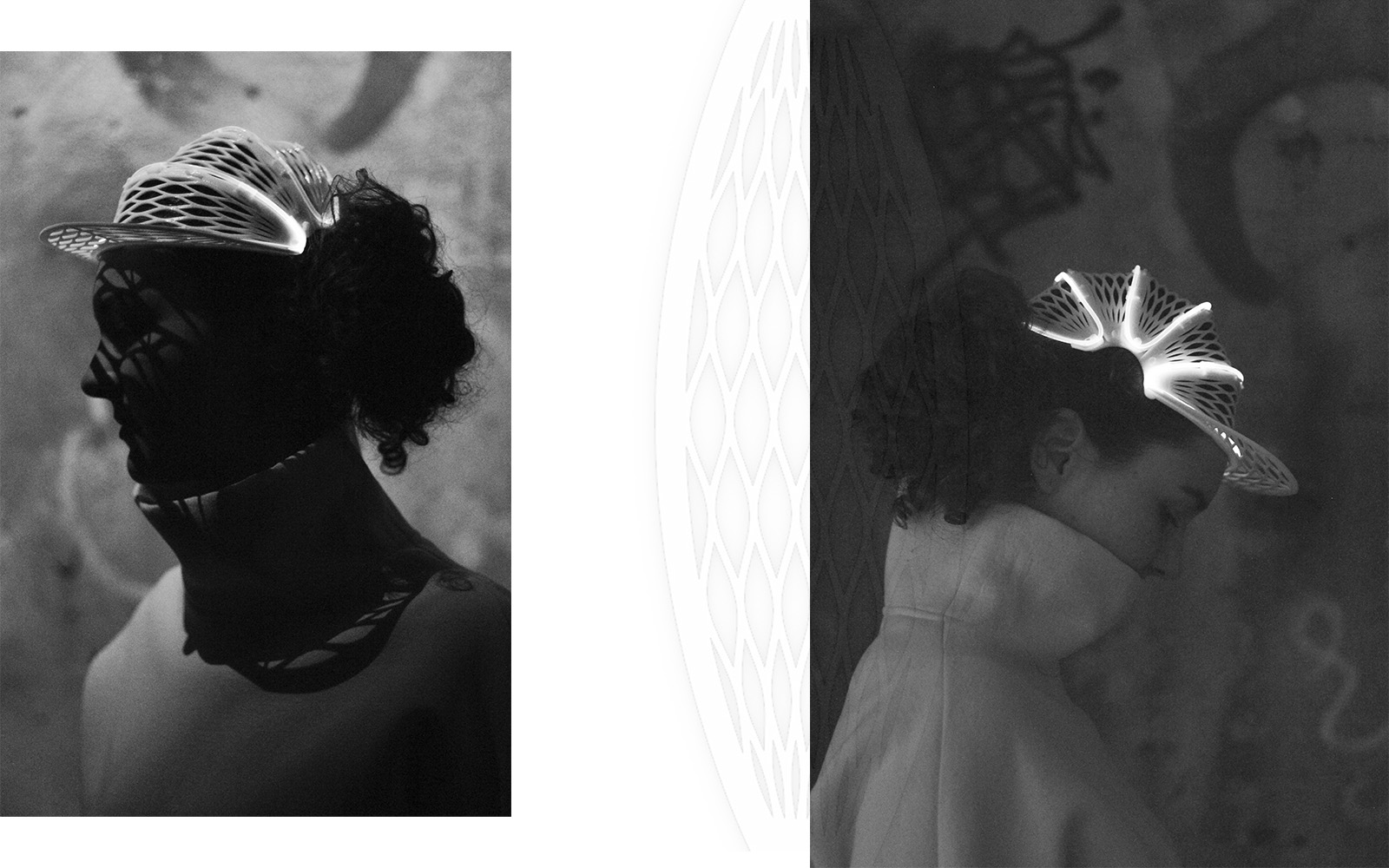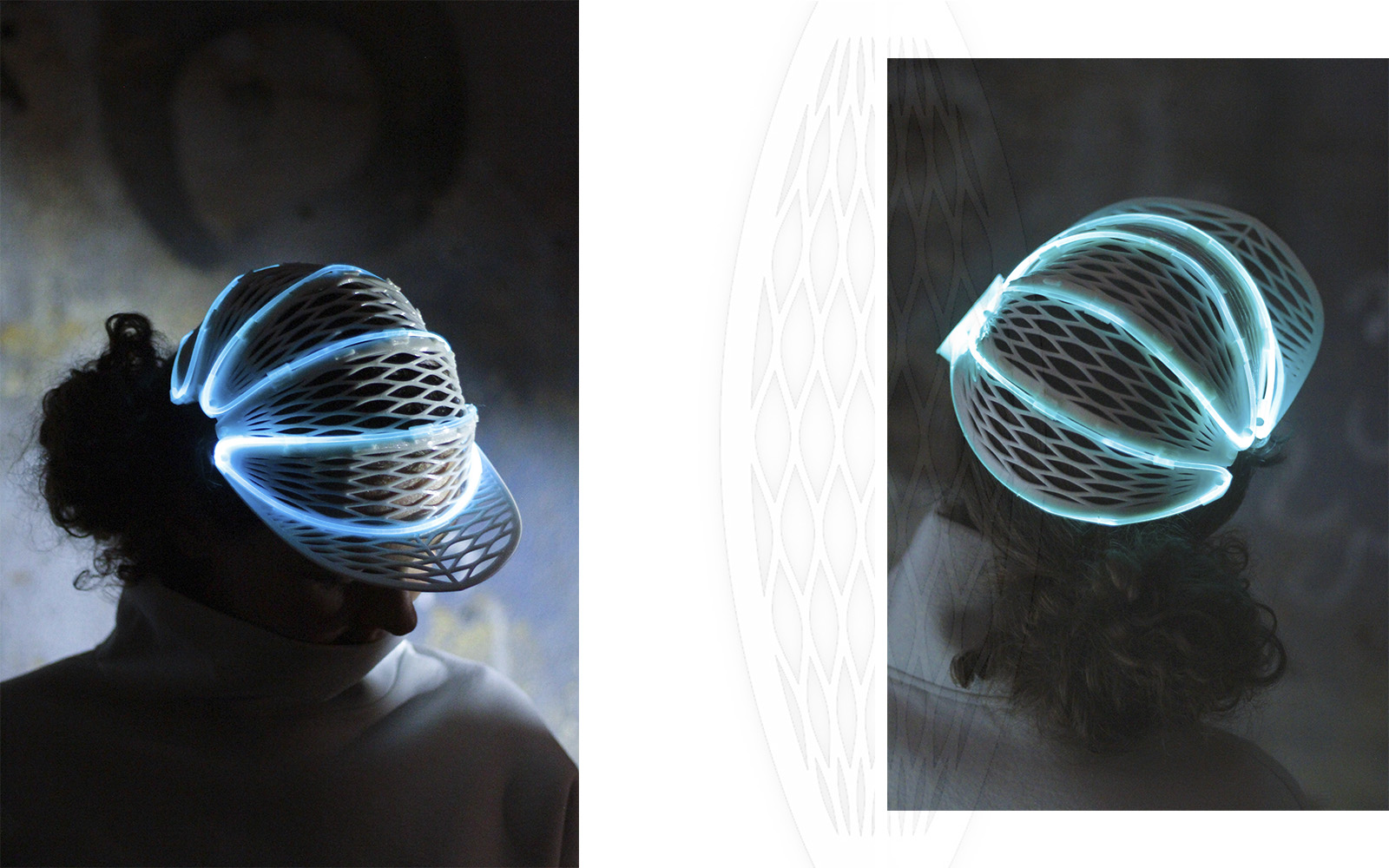7. COMPUTATIONAL COUTURE#
Inspiration#
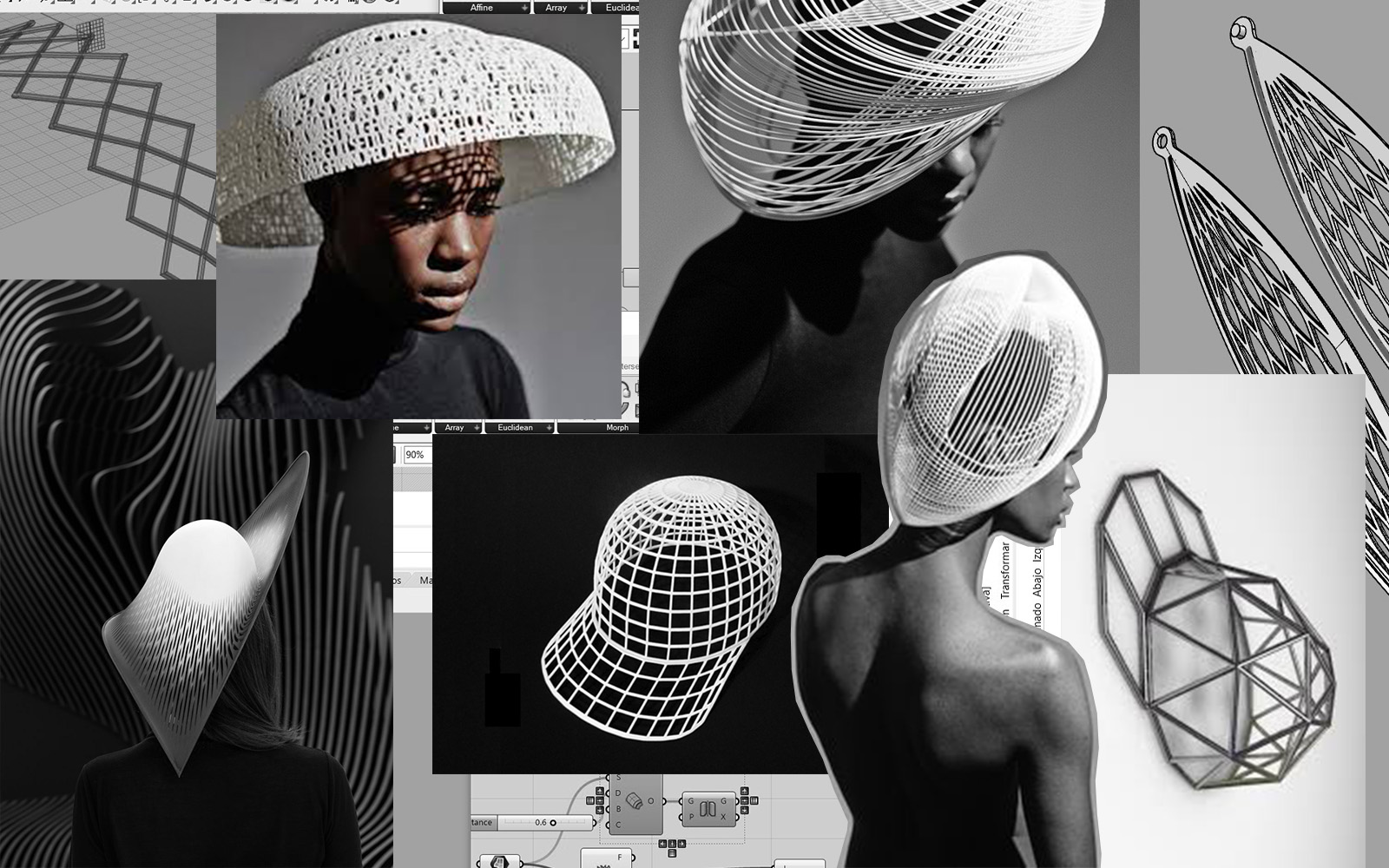
I looked forward to the arrival of this assigment, since using 3D printing in my field, the millinery, was something I longed for long before the course began; I have some references that had already included this tool in their collections of accessories for the head, but when I saw them, I had so many doubts: how do they do it? How to design a piece to print in 3D? How do they achieve volume? How do the machines work? What materials do they use? How long does it take to print? What programs do they use? Etc In this week and later in which I continued working on the subject I could clear several doubts about it, it is a way that I intend to continue exploring since the possibilities are almost endless, the pieces that can be reached through 3D printing can have complex morphological qualities and very difficult to achieve with other tools.
Referents in the use of 3D technology in fashion and millinery:
Computational Design Process / Diadema#
My first idea to print in 3D, as an accessory for the head, was a “Diadema” or “headband”. After classes, tutorials and experimentation with Grasshopper I decided to launch and start the design from scratch there. The intention from the beginning was to create a three-dimensional piece, with the appropriate curvature and scale to be carried on the head, which made the process from the beginning more complex, since it had to introduce real measurements.

- First I started drawing the base curve line, which I then copied 4 times and rotated around an axis, thus achieving contour and virtual surface of the accessory itself.
- The next step was to locate equidistant points along each curve, which will then serve as joining axes to achieve a plot.
- After trial and error, I managed to connect the points with diagonal lines, forming a plot with diagonal lines forming rhombuses. With the command “pipe” I could give them three-cylinder shape, introducing the diameter value. I arrived (after several hours connecting and disconnecting commands in Grasshopper) to a model that on the screen looked good, but to be printed in 3D it had little structure, very sharp angles and no point of support where the machine could start printing without have to add “supports” of material.
- To achieve greater structure and a morphologically adequate result to print in 3D, I decided to create a uniform surface, using the initial lines of the design, to serve as support for the diamond pattern; they join at the ends, but it has a slight curvature that allows the finest weft to take off.

- The extension of commands and unions between them can be observed in the Grasshopper window, until reaching the final object; eager to get to the first sample I decided that the piece was finished, for this you must use the command “Cooking” and then the piece is ready to manipulate in Rhino.
- Once in Rhino, I had to verify that the piece was suitable for printing, the advantage is that every time you want to export the Selection in STL format, the program marks you the errors, sectors that can not be prototyped, surfaces that are not closed, elements that are repeated, etc. The first few times I had to “clean” the object, turn it into mesh, polysurface, and see which option was more convenient for me.
- With the object exported in STL format, I used the CURA software to preview the object’s printing, add a removable support (Raft) and the appropriate parameters according to the material to be used (in this case PLA) and the printer (temperature of extruder, bed, etc).

- The piece took approximately 4 hours to print, although in scale and process it worked (the file could be printed completely and not broken) the final result was not expected aesthetically, (it does not have a good finish) but it was useful to observe in particular the errors and parameters regarding the design before correcting. This did not discourage me, since it was my first prototype, on the contrary, it generated new ideas and intentions to continue investigating and designing.
Computational Design Process / Modular Cap#
At first, my idea was to create another “headband” model but this time using another material: Flia-Flex filament, which would allow me to create a flat module but with the possibility of being curved by its flexible property.
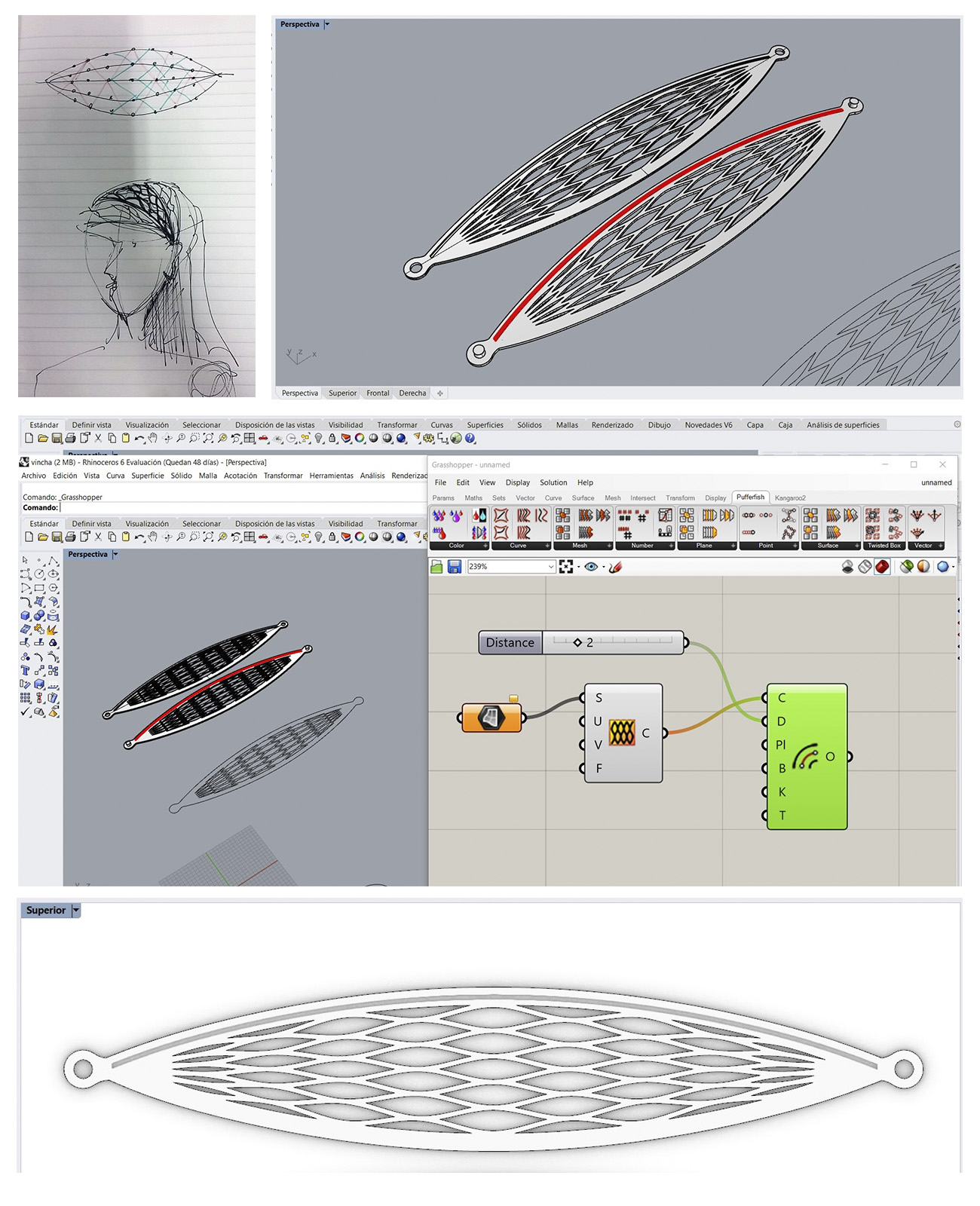
After experimenting with Grasshopper, I decided to start with a simpler module, creating a flat surface, which I could then modify with a single command:
-
Net On Surface: A component that creates a network as a series of curves on a surface. The curves flow along the surface between the divisions, no matter how low the UV division count is, instead of connecting directly from one point to another. Some interesting deformed webs can be achieved by deforming the UV on the input surfaces by pulling the control points on the surface. The network works on both open and closed surfaces and can be turned in the direction along the surface with the lid entry. The component will go to the Curve> Spline tab.
After having created a plot manually, with this command that I downloaded, I could apply it in a single step and achieve a very interesting plot, with extension capacity in conjunction with the row-flex. Continuing with the axes worked in the Assiggment “circular fashion” I decided to include a locking system (similar to Zip bags) to join one module with another and thus achieve a “helmet” together. When printing the first piece, it was fascinating for me to see the stretch capacity that the piece possessed and its aesthetic qualities. It was not like that with the embedded system, but that led me to think about the evolution of the module to arrive at a more complex object: a MODULAR CAP.
Week 06. COMPUTATIONAL COUTURE / 3D Print / Fila-Flex from Betiana Pavon on Vimeo.
Better results with the FILAFLEX / tips:#
- A very slow 3D printing speed. 20 mm/s works well.
- A thick layer parameter. We did not manage to get good print results with 100 microns layers, but at 200 microns the results were good.
- 120% flow rate.
- Retraction of 3 mm and Retraction speed of 50 mm/s.
- Extrusion temperature of 240 or 245°C
Modular Cap#
Step by Step:
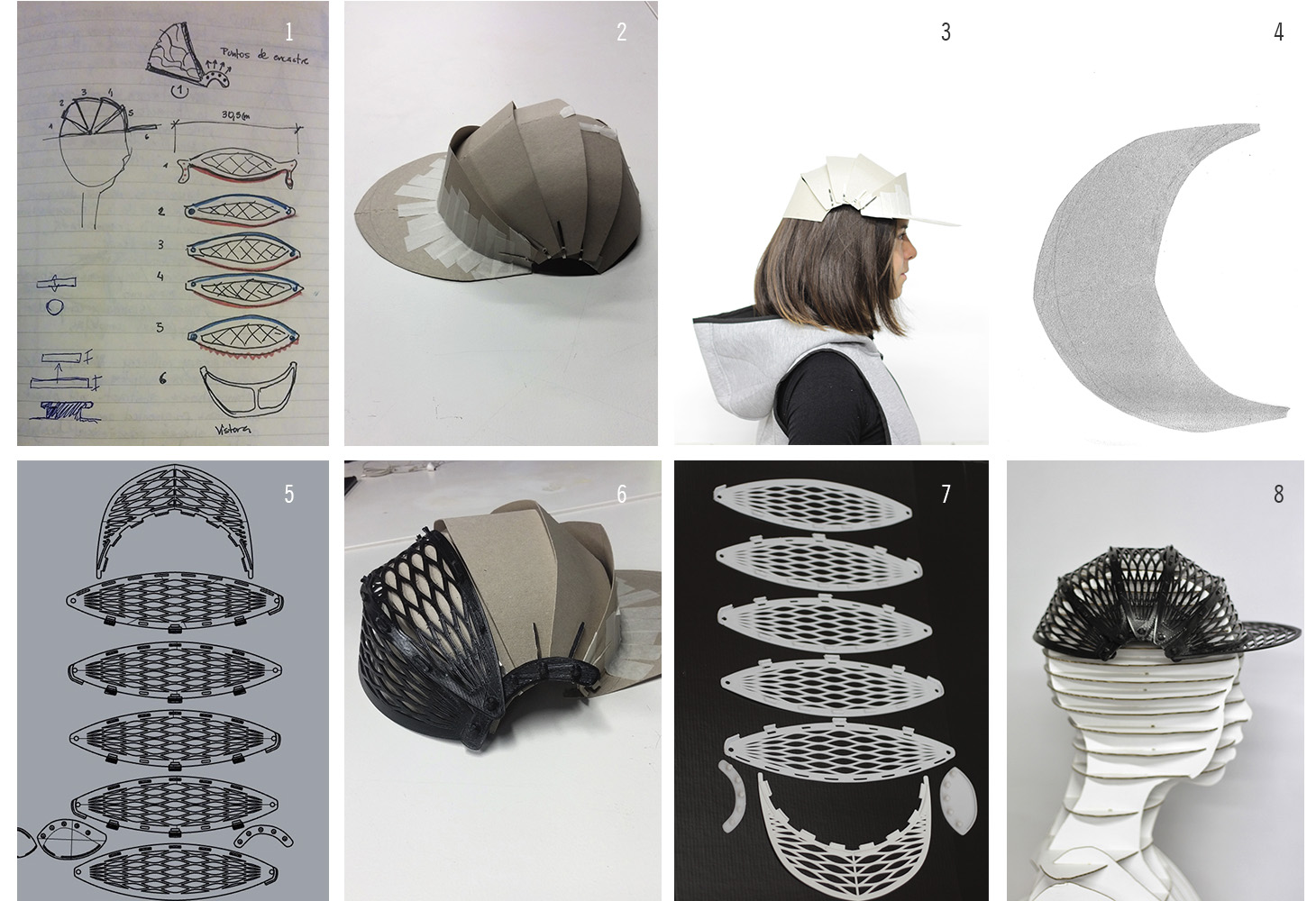
- 1 I always start with my paper design process, although I already had the digital module designed, I had to adjust measurements, scale and design new fitting pieces.
- 2 Old school: the accessories of the head must be precise in terms of measurements and functionality, for it I decided to return to manual tools of fast layout; cardboard, scissors and tape. Constructing the object in a tangible way, this helped me to visualize new alternatives of lateral insertion and not to make mistakes in the digital archives; thus saving time and printing material.
- 3 with the piece mounted, I could thus adjust the measures and ergonomics of the accessory on real heads.
- 4 A large window that Rhino has is that we can import images, as my cardboard modules worked well, I decided to scan them in 2D and accelerate the digital drawing process, being able to trace contours and general curves, then take them to a fully symmetrical digital drawing .
- 5 Once the base module was finished, only the rest remained to be copied and scaled down. Extrude and position the “buttons” to fit, it is important that they are arranged symmetrically.
- 6 Each piece (6 in total) has an approximate printing time of 2hs. As I was printing I could go riding the object. What is remarkable in the use of this type of technology is that this design can be sent and reproduced anywhere in the world, since it is enough to send the digital files in STL format and the appropriate parameters for the subsequent printing.
- 7 The materials used to build the prototype were the filaments for 3D printing: Fliaflex, for the modules corresponding to the helmet part of the cap, which required to be flexible and adaptable to the curved and spherical shapes of the head; and PLA for rigid and flat modules (visor and sides with snap buttons) these pieces are what give structure and stability to the piece.
- 8 Accessory finished, a clear similarity can be observed between the manual model and the final result.

Cap AURORA / external project#
- Prototype selected in the contest “DIGITAL MADE” of Fondazione Mondo Digitale / Roma / Italy / 2019
The prototype cap Aurora, is a design created jointly by Ana Correa and Betiana Pavón; which consists of a modular Cap (accessory for the head) with the addition of an electronic system that allows the morphology to stand out in the dark through fiber optics. This project was carried out jointly and thanks to the knowledge acquired in the Fabricademy program. (Computational Couture / E-Textiles and Wearables)

- Assembly of the modules
